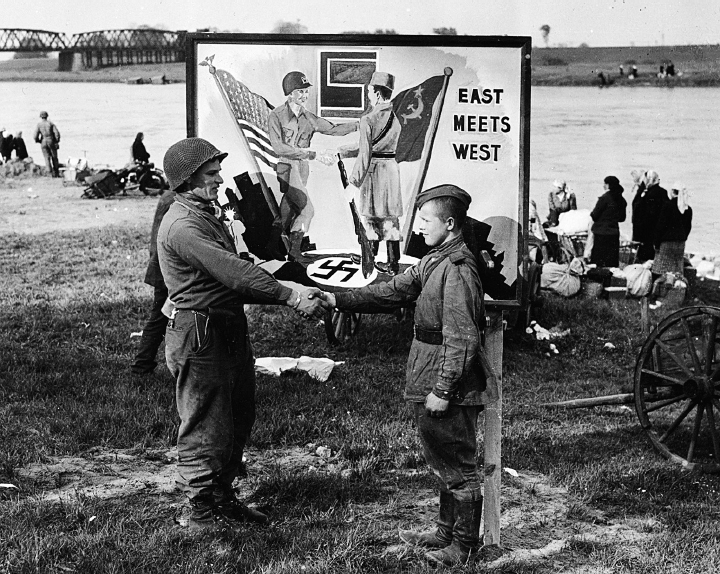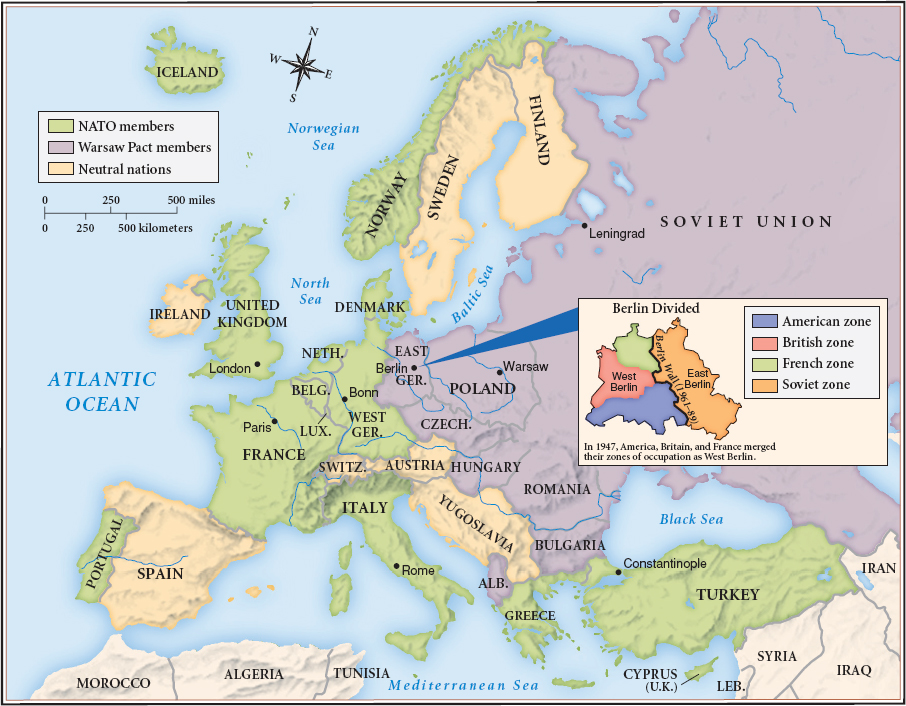America’s History: Printed Page 806
America: A Concise History: Printed Page 731
America’s History: Value Edition: Printed Page 711
Origins of the Cold War
World War II set the basic conditions for the Cold War. With Germany and Japan defeated and Britain and France weakened by years of war, only two geopolitical powers remained standing in 1945. Even had nothing divided them, the United States and the Soviet Union would have jostled each other as they moved to fill the postwar power vacuum. But, of course, the two countries were divided — by geography, history, ideology, and strategic interest. Little united them other than their commitment to defeating the Axis powers. President Franklin Roosevelt understood that maintaining the U.S.-Soviet alliance was essential for postwar global stability. But he also believed that permanent peace and long-term U.S. interests depended on the Wilsonian principles of collective security, self-determination, and free trade (see “Catastrophe at Versailles” in Chapter 21).
Yalta At the Yalta Conference of February 1945, Wilsonian principles yielded to U.S.-Soviet power realities. As Allied forces neared victory in Europe and advanced toward Japan in the Pacific, Roosevelt, Churchill, and Stalin met in Yalta, a resort in southern Ukraine on the Black Sea. Roosevelt focused on maintaining Allied unity and securing Stalin’s commitment to enter the war against Japan. But the fates of the nations of Eastern Europe divided the Big Three. Stalin insisted that Russian national security required pro-Soviet governments in Eastern Europe. Roosevelt pressed for an agreement, the “Declaration on Liberated Europe,” that guaranteed self-determination and democratic elections in Poland and neighboring countries, such as Romania and Hungary. However, given the presence of Soviet troops in those nations, FDR had to accept a pledge from Stalin to hold “free and unfettered elections” at a future time. The three leaders also formalized their commitment to divide Germany into four administrative zones, each controlled by one of the four Allied powers, and to similarly partition the capital city, Berlin, which was located in the middle of the Soviet zone.

At Yalta, the Big Three also agreed to establish an international body to replace the discredited League of Nations. Based on plans drawn up at the 1944 Dumbarton Oaks conference in Washington, D.C., the new organization, to be known as the United Nations, would have both a General Assembly, in which all nations would be represented, and a Security Council composed of the five major Allied powers — the United States, Britain, France, China, and the Soviet Union — and seven other nations elected on a rotating basis. The Big Three determined that the five permanent members of the Security Council should have veto power over decisions of the General Assembly. They announced that the United Nations would convene for the first time in San Francisco on April 25, 1945.
Potsdam Following the Yalta Conference, developments over the ensuing year further hardened relations between the Soviets on one side and the Americans and British on the other. At the Potsdam Conference outside Berlin in July 1945, Harry Truman replaced the deceased Roosevelt. Inexperienced in world affairs and thrown into enormously complicated negotiations, Truman’s instinct was to stand up to Stalin. “Unless Russia is faced with an iron fist and strong language,” he said, “another war is in the making.” But Truman was in no position to realign events in Eastern Europe, where Soviet-imposed governments in Poland, Hungary, and Romania were backed by the Red Army and could not be eliminated by Truman’s bluster. In Poland and Romania, in particular, Stalin was determined to establish communist governments, punish wartime Nazi collaborators, and win boundary concessions that augmented Soviet territory (the Soviet leader sought eastern Polish lands for the Soviet Union and sought to make far northeastern Germany part of Poland).
Yalta and Potsdam thus set the stage for communist rule to descend over Eastern Europe. The elections called for at Yalta eventually took place in Finland, Hungary, Bulgaria, and Czechoslovakia, with varying degrees of democratic openness. Nevertheless, Stalin got the client regimes he desired in those countries and would soon exert near-complete control over their governments. Stalin’s unwillingness to honor self-determination for nations in Eastern Europe was, from the American point of view, the precipitating event of the Cold War.
Germany represented the biggest challenge of all. American officials at Potsdam believed that a revived German economy was essential to ensuring the prosperity of democratic regimes throughout Western Europe — and to keeping ordinary Germans from turning again to Nazism. In contrast, Stalin hoped merely to extract reparations from Germany in the form of industrial machines and goods. In exchange for recognizing the new German-Polish border, Truman and Secretary of State James Byrnes convinced the Soviet leader to accept German reparations only from the Soviet zone, which lay in the far eastern, and largely rural, portion of Germany and promised little wealth or German industry to plunder. As they had done for Europe as a whole, the Yalta and Potsdam agreements paved the way for the division of Germany into East and West (Map 25.1).

Yalta and Potsdam had demonstrated that in private negotiations the United States and the Soviet Union had starkly different objectives. Subsequent public utterances only intensified those differences. In February 1946, Stalin delivered a speech in which he insisted that, according to Marxist-Leninist principles, “the unevenness of development of the capitalist countries” was likely to produce “violent disturbance” and even another war. He seemed to blame any future war on the capitalist West. Churchill responded in kind a month later. While visiting Truman in Missouri to be honored for his wartime leadership, Churchill accused Stalin of raising an “iron curtain” around Eastern Europe and allowing “police government” to rule its people. He went further, claiming that “a fraternal association of English-speaking peoples,” and not Russians, ought to set the terms of the postwar world.
The cities and fields of Europe had barely ceased to run with the blood of World War II before they were menaced again by the tense standoff between the Soviet Union and the United States. With Stalin intent on establishing client states in Eastern Europe and the United States equally intent on reviving Germany and ensuring collective security throughout Europe, the points of agreement were few and far between. Among the Allies, anxiety about a Nazi victory in World War II had been quickly replaced by fear of a potentially more cataclysmic war with the Soviet Union.
UNDERSTAND POINTS OF VIEW
Question
How did American and Soviet viewpoints differ over the postwar fate of Europe?